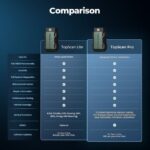The OBD (On-Board Diagnostics) system is crucial for identifying car problems. It uses alphanumeric codes, known as OBD2 codes or Diagnostic Trouble Codes (DTCs), to signal malfunctions within the vehicle’s systems. Understanding these codes is essential for effective troubleshooting and repair. This comprehensive guide will delve into the structure and meaning of OBD2 codes, empowering you to better understand your car’s health.
To retrieve OBD2 codes, a diagnostic tool needs to be connected to the OBD2 port, usually located under the driver’s side dashboard. While affordable diagnostic tools are available, using professional-grade equipment operated by qualified technicians is highly recommended for accurate diagnosis and repair.
Why Does the Check Engine Light Turn On?
The check engine light illuminates when the vehicle’s electronic system, managed by one or more ECUs (Electronic Control Units), detects a problem. This trigger prompts the OBD2 system to store a corresponding code, indicating the nature of the malfunction.
Deciphering OBD2 Codes: Structure and Meaning
OBD2 codes follow a standardized five-character alphanumeric format. Each character provides specific information about the fault:
First Digit: System Identification
- P: Powertrain (engine, transmission, emissions)
- B: Body (airbags, power seats, central locking)
- C: Chassis (ABS, suspension, steering)
- U: Network communication (CAN bus, modules)
Second Digit: Code Type
- 0: Standardized generic codes defined by SAE (Society of Automotive Engineers). These codes are common across all vehicle makes and models.
- 1: Manufacturer-specific enhanced codes. These codes provide more detailed information related to specific vehicle systems and components.
Third Digit: Subsystem
- 1 & 2: Fuel and Air Metering
- 3: Ignition System or Misfire
- 4: Auxiliary Emission Controls
- 5: Vehicle Speed Control and Idle Control System
- 6: Computer Output Circuit
- 7: Transmission
- 8: Transmission
- 9: SAE Reserved
Fourth & Fifth Digits: Fault Code
These two digits pinpoint the specific problem within the subsystem identified by the third digit. For instance, P0301 indicates a misfire in cylinder 1.
Common OBD2 Codes (P0010 – P0849)
Below is a partial list of common generic OBD2 codes related to powertrain issues:
- P0010: “A” Camshaft Position Actuator Circuit (Bank 1)
- P0011: “A” Camshaft Position – Timing Over-Advanced or System Performance (Bank 1)
- P0012: “A” Camshaft Position – Timing Over-Retarded (Bank 1)
- P0100: Mass or Volume Air Flow Circuit Malfunction
- P0130: O2 Sensor Circuit Malfunction (Bank 1 Sensor 1)
- P0300: Random/Multiple Cylinder Misfire Detected
- P0400: Exhaust Gas Recirculation Flow Malfunction
- P0420: Catalyst System Efficiency Below Threshold (Bank 1)
- P0700: Transmission Control System Malfunction
This list is not exhaustive, and manufacturer-specific codes exist beyond these generic codes. Consulting a reliable OBD2 code database or a qualified technician is crucial for accurate interpretation and diagnosis.
Conclusion
Understanding OBD2 codes is essential for car owners and technicians alike. These codes provide valuable insights into the inner workings of a vehicle, enabling efficient troubleshooting and repair. While this guide offers a foundational understanding, leveraging comprehensive OBD2 code resources and professional expertise is vital for accurate diagnosis and resolution of car problems. Remember, early detection and addressing of issues indicated by OBD2 codes can prevent costly repairs and ensure optimal vehicle performance and longevity.

